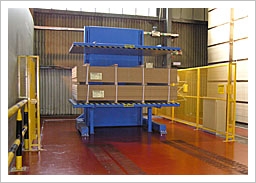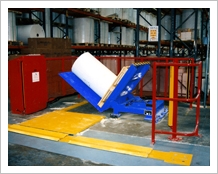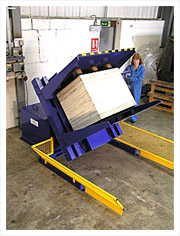
RR Type 1 pallet inverter When the situation calls for a really heavy capacity system Premier have the RR Type 1 to offer. RR stands for "recline and rotate" which describes the machine's operating principle. The load is clamped, tipped back through 90° and then rotated on a turntable through 180° before returning to the upright position. It means the weight is perfectly distributed at all times. This had proved to be a highly stable and reliable means of coping with abnormal loads.
The RR Type 1 Inverter has specific applications in the automotive and other steel-related industries. Its ability to handle loads of up to 20,000lbs makes it ideal for the 180° inversion of pressed car body panels. Every car has a left and right side so 50% of the panels have to be turned prior to assembly. The RR is also used for inverting steel or aluminium in the shelving, office furniture and flooring industries.
In addition to its high weight capacity the RR Inverter provides the ideal solution to problems inherent in turning very wide stacks of product, so you will find this machine turning mdf board, timber panels and cardboard.
It is always supplied as an automated system, fully guarded protected. On most occasions the RR is designed as a dual clamp system but when very high compression is required with slippery product we build the RR with one powered clamp closing on a fixed table.
Each RR Pallet Inverter is a one-off, built entirely to the customer's specification of load, weight and dimensions. Premier guarantee a successful solution to these difficult handling problems every time.

Our 90° tipper is a natural development of the original inverter products that Premier is known for. The 90 Tipper was created out of a need for a solution to tip steel and paper coils at a 90-degree angle. These specialised machines are the perfect answer to the problem. The 90 Tipper uses hydraulics that push cam mounts in the corners of the tables to tilt the product. This is different to the typical "rack and pinion" design used in other inverter machines.
Premier custom builds all the 90 Tipper units to the customer's specifications to ensure that their needs are completely fulfilled. This allows the tipper to perform at its best depending on the type of load that it is to be used with. The customer can choose from three main design set-ups that can be easily adapted to fit their own needs. There are many industries that may have the need for this type of unit, which can save time and money during either production, or delivery of the products.
This model is also sometimes referred to as a Roll Upender and a Coil Upender

In line inverters were developed to meet the needs of high throughput users whose loads are travelling on conveyors and who need to incorporate pallet transfer or inversion into their system.
Most of Premier's inverter models can be adapted in some way that they can be fed by conveyor. The company's system designers look at each application on its merits and create a custom-built solution using whichever style is best suited.
In some cases there is simply a necessity to turn every incoming load through 90° so that it continues down the line upside-down. This can apply to cases of wine or stacks of cardboard sheet.
In other cases the requirement is to use an In-Line Inverter to switch goods from one type of pallet to another. In the past, the FS DC model has most often been adapted for this purpose, sometimes with the sidewall swinging clear to allow the free-passage of goods.
More recently the Pallet Changer, situated to one side of the line, is seen as the ideal alternative. This model has the advantage that the loads are presented back on the conveyor the original way up after pallet exchange. It is also possible to feed a new pallet in and recover and stack the old one using conventional pallet stackers, also to one side of the main conveyor.
Premier will be pleased to specify and quote for the In-Line Inverter which is most applicable to any automated pallet-handling system.

The RR Type 2 pallet inverter works on a similar "recline and rotate" principle to the Type 1 , but conversely it is seen primarily as a means of inverting small, shorter loads. The product is introduced to the machine at floor level by powered or hand pallet truck. It is then clamped and tilted back hydraulically before being spun through 180° by hand.
Most users of the RR Type 2 Inverter will be handling stacks of paper or boxed goods and will require a machine to work in a restricted space under limited headroom. It is the system of choice for printers who need to turn the paper pile for reverse side printing or for the smaller warehouse where finished goods need to be switched to shipping pallets.
The RR Type 2 Inverter only requires a 3 phase electrical connection and has a 2250lbs capacity. Some design changes are possible if loads do not quite meet its standard parameters. Though normally secured to the floor it is perfectly stable under its own weight.